
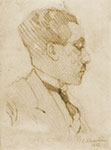
1894-1975
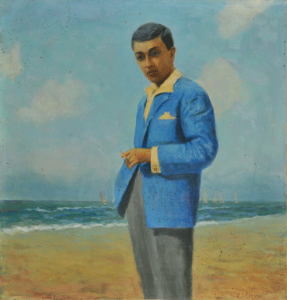
Self-Portrait – Ras El-Bar – 1931 – Oil on wood
Charobim was one of the first Egyptian artists to graduate from the Academy of Fine Arts of Rome in 1923.
When he returned to Cairo with a degree in painting, he was honored by King Fouad I with a teaching position at the then newly opened School of Fine Arts in Cairo. However, fascinated with painting, the free-spirited artist decided to reject the constraints that went with the appointment and opted to follow the path of his passion by devoting himself to painting.
Of all the Pioneer-generation painters in Egypt, Charobim was perhaps the richest in his artistic reproductions of nature, which he created in startling detail. Primarily a landscape painter, the prolific artist emphasized the vibrancy of color of Egyptian landscapes, which frequently appear flooded with light.
His paintings praise the beauty of a romantic and serene Egypt, where life was simple and people were carefree.
Chafik Charobim, born on November 4, 1894, was the first child of Michail Bey Charobim (1861-1918) and Henena Badir (1865-1952), and was followed by four siblings. His father was a chief judge as well as a writer and historian, whose most notable work “El Kafy”, available at the library of the Cairo Coptic Museum, is a five-volume compendium on Egypt’s ancient and modern history.
In 1900, his father was transferred from Cairo to Alexandria, where he rented a small palace in Moharam Bey, for the family. The young Charobim attended his primary classes at St. Andre’s School there. The palace home with its surrounding gardens left a lasting impression on the artist-to-be, who retained memories of the palm trees and bright colored flowers, and later sketched them from memory. The family’s stay in Alexandria lasted three years, and upon their return to Cairo, Charobim was sent to St. Mary’s School in Garden City. It is then that he began to sketch, with the encouragement of one of his father’s cousins, himself an amateur painter.
Charobim’s father had high hopes of his son becoming a doctor and dismissed his art work as child play. However, the passion for art had already taken hold of the young artist. He sketched and drew under the direction of his school art teacher, who had quickly depicted his talent. When he later attended secondary school at the Collège de La Salle at Koronfiche, Father Léon, who taught drawing and painting, mentored and guided him as well. Recognizing the young man’s talent, he asked Charobim Bey to send the young man to study painting in Europe. The notion of his oldest son shirking recognized academic studies was out of question for the father, although he was prepared to settle for a career in engineering for his son. Meanwhile, Charobim constantly sketched portraits of his teachers and classmates, who gladly posed for the aspiring artist. To satisfy his love of art, he also took painting lessons with several European artists who resided in Egypt at the time, including Tennyson Cole: portraitist to King George V.
Bending to his father’s wishes, he attended the Faculty of Civil Engineering at Fouad I University (now Cairo University). However, his father’s death in 1918 changed the course of his life. Already in his third year of school, he dropped his studies and took over the management of the family’s agricultural estate. By 1921, he married Marie Ghali and they left for Italy to fulfill his aspiration of obtaining an academic art education. It was in Rome, in 1923 that their son, Ramses was born.
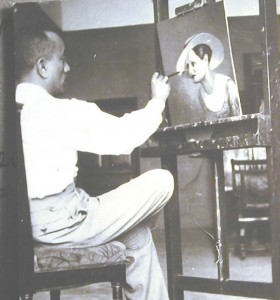
Charobim at his easel – Rome 1922
At the Academy of Fine Arts in Rome, and coached by his mentor Professor Umberto Coromaldi (1870-1948), Charobim studied landscape, portraiture, still-life, and the nude. He excelled in oil paintings of moderate sizes on wood and canvas. He was influenced by impressionist painters, namely Alfred Sisley, Pierre-August Renoir, Camille Pissarro and Paul Cézanne , but was above all fascinated with the work of Jean-Baptiste-Camille Corot, a pivotal figure in landscape painting, whose vast output simultaneously references the Neo-Classic tradition and anticipates the plein-air innovations of Impressionism. Eventually Charobim developed his own unique style, which cannot be adequately categorized with other artists.
While in Europe he met and became life-long friends with his compatriot painters, Youssef Kamel and Ragheb Ayad as well as with Mohamed Abdel Kouddous who was studying Dramatic Art at Saint-Cyr, France.
During an era when art flourished in Egypt, Charobim, alongside Orientalist painter Roger Breval, sculptor Mahmoud Mokhtar, painter Ahmed Sabri, and others founded the artists’ group “La Chimère” also known as “Friends of the Arts”. The setting located on the ground floor of a building on Antikhana Street in Cairo’s down town area served as studios as well as exhibitions space for eminent academic artists. Other than the founding members, artists included Beppi Martin, Mahmoud Said, Mohamed Hassan, Nagy and Youssef Kamel. Roushdi Pacha, president emeritus often visited and bought their works.
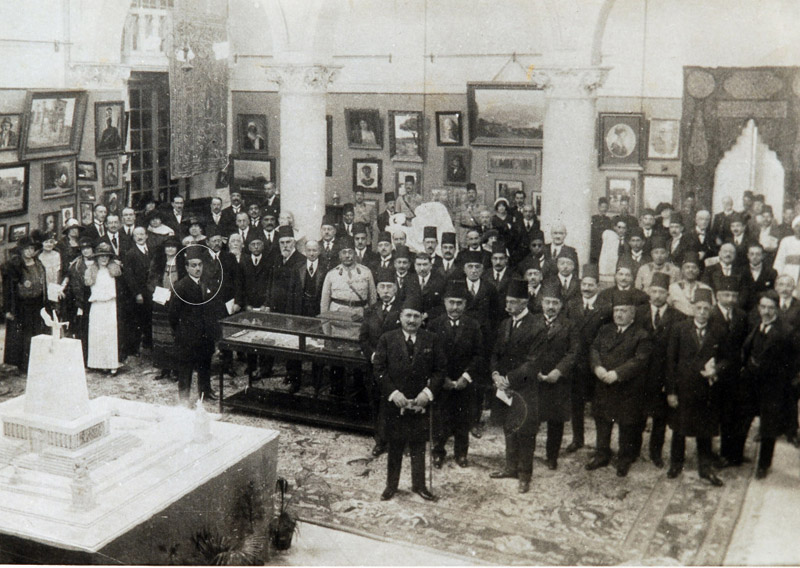
In 1923, the Friends of the Arts collective organized their first exhibition, showing the works of a number of Egyptian painters and sculptors. It was inaugurated by King Fouad I, who bought one of Charobim’s paintings entitled The Dog. The sculpture in the forefront is Mahmoud Mokhtar’s Al-Nahda Al-Masriya (Renaissance).
His wife died in 1927, following a long and painful illness, leaving him with the care of their five-year old child. During that period, the artist’s somber mood was reflected in his limited paintings, mostly of sunsets. He began reading extensively, and his interests ranged from history, politics and philosophy to animal life, medicine, and naturally to art and its history. Also, being an intensely sociable man, he kept a close relationship with his extended family, friends and neighbours.
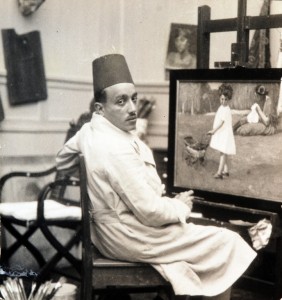
Charobim in his studio at Helwan – early 1930’s
Besides painting, Charobim had an intense passion for hunting. It was through his numerous hunting trips that he became familiar with the varying landscapes, flora and fauna of Egypt. These trips not only allowed him to journey all over Egypt, but also took him all the way to Sudan. At each spot, he would sketch his observations of scenery as well as people or animals that caught his eye. He also often photographed and made notes from passersby in motion to preserve and study the informality of action and movement of people or animals in their natural environment. He then worked from these sketches to create his completed paintings.
He was an accomplished pianist and frequently organized musical session at his Helwan villa. He also loved animals and kept in the garden dogs, cats, a goat, a monkey, as well as various other animals and birds in the garden. His fondness of animals is reflected in many of his works.
In 1939 the Egyptian Shooting Club was founded and Charobim was its sixth member. For the rest of his life he regularly participated in the club’s activities and shooting competitions and won numerous trophies in recognition of his shooting proficiency as a marksman.
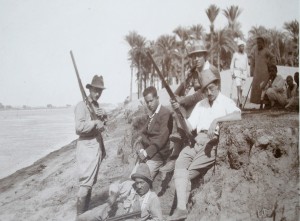
Charobim pictured at a hunting expedition with his friends from the Royal Shooting Club of Egypt – Badrashein – 1939
In 1940, following his son’s graduation from university, he volunteered for a year at the Police Academy. During the same year, he married Marie Greis, his late wife’s cousin. They had two children; Yehia and Marion. It is during these years that he produced the majority of his work. From in and outside of his studio, he painted scenes from Egyptian everyday life and portraits on a daily basis. During the summer months he would take his family to Rosetta, Alexandria or Ras El-Bar. The months spent on Egypt’s seashores inspired him to produce compelling works of the Mediterranean and its shores in which one can nearly sense the smell of iodine. On a few occasions in the 1950s, the family spent summers in Lebanon instead. Its mountains, valleys, and villages provided the artist with visual material that he drew upon in numerous works.
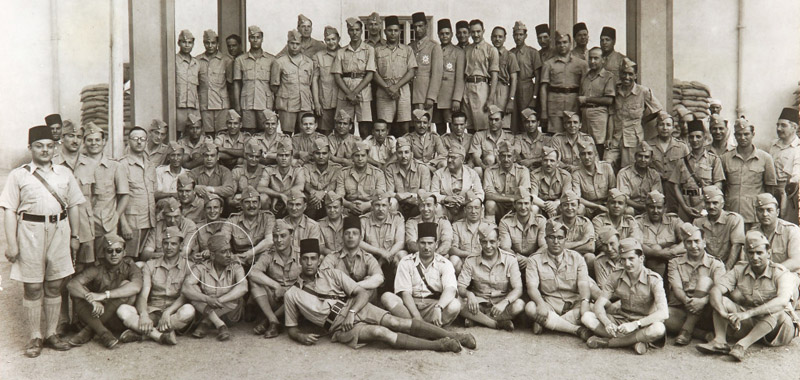
Charobim at the Police Academy – 1940
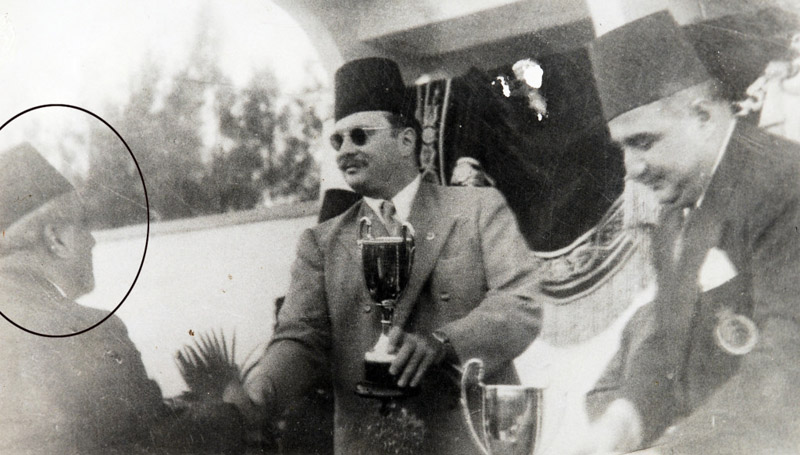
Charobim receiving a trophy from King Farouk I at the Shooting Club – 1949
Throughout the major part of his life, Charobim retained the same enthusiasm and vigor with which he had started his career. He often remarked that a happy man was a busy one, and indeed he was actively busy and happy, always conveying delight to those who were lucky to be around him. In his old age he would say “I see and live my youth through my works which I paint with the colors of nature”.
Charobim’s work transmits to the viewer a realistic vision, often imprinted with the pureness of Egyptian landscapes and skies in exquisite colors. He strove to unite the discipline of classical art with the immediacy of impressionism. His work is notable for its careful reproduction of form, its organic and genuine character, and its consummate craftsmanship. Inclined to conciseness and simplicity, he excelled in small paintings, masterpieces of moderate dimensions, of limited meticulous designs and ranges. For his choice of subjects drawn from ordinary everyday life, and more specifically for his profound understanding of agriculture coupled with his anatomical craftsmanship, his work is revered as a realistic yet romantic documentation of twentieth century Egypt. His themes are expressed in colorfully angular, simplified, expressive, and richly inspiring effects. He remained perfectly loyal to a basis of subject matter – and this allowed him to go very far in experimenting with style and colour, so that he could become the distinguished Egyptian artist we remember today.